By Susan MacMillan, ILRI

Speaking on ‘Sustainable food systems for food security’, Marianne Banziger, a scientist at the CGIAR maize and wheat centre (CIMMYT), this afternoon gave a ‘Rank Lecture’ at the Planet Under Pressure Conference in London.
She began with a bald statistic: To meet the food security challenges converging over the next 50 years, she said, we will have to produce as much food as has been consumed over the entire history of humankind.
Things did not get better after that.
We can expect more food price hikes, she argued, like those the world experienced in 2008 and 2010. Those peaks were due to low stocks; food prices went up three-fold and food prices have never returned to 2006 levels.
A large part of the changing food situation, Banziger explained, is due to the many people in developing countries that are newly incorporating into their largely starch-based diets meat, milk and eggs. However, most people gaining a bit of disposable income for the first time and using it to buy animal-source foods are still consuming far less of these foods than people in rich countries.
Biofuels are complicating the situation further: some 40% of the US maize crop now goes to biofuel, which is more than what is produced for animal feed.
Food price increases push people back into poverty, she reminded her audience. As food prices increase, and people find food less and less affordable, the proportion of their consumption of staple crops increases. If we do not act, food and energy price inflation will exceed income growth of the poor—pushing them further into poverty.
Living on borrowed resources
What goes up must come down: As fertilizer prices go up, the profitability and yields of smallholder farmers in developing countries go down.
Some 300 million people in India and China are sustained with grain grown from the over-pumping of water (that is, water resources not renewed by rainfall).
Social unrest is likely to come back again and again; deforestation, water scarcity and human migration are all likely to increase,
We still have the time to act.
Science usefully provides us with options.
We could reduce our consumption of food. How many of us now recycle and conserve water? Reduce food wastage? Eat less meat? These actions reduce demand. Those people now climbing out of poverty have as much right as we do to eat well.
On the other hand, we could increase our production of food.
The more we delay investments in this, the steeper will be the challenges we face.
Among new opportunities for increasing productivity are use of precision agriculture and cell phones (for conducting financial transactions, buying crop and input insurance).
We should not make the same mistakes as in the past by focusing on higher productivity alone. Farmers also need to generate greater income, to build greater resilience to shocks, to conduct sustainable farming, and to access viable markets and value chains.
Eyes wide open
Closing the yield gap among today’s marginalized farmers will not be enough, Banziger said. Farmers in the Indo-Gangetic Plains now grow wheat for 700 million people. But the encroachment of heat on these plains is expected to reduce yields 20–30% by 2050.
We need to explore the untapped biodiversity of staple crops. Drought-tolerant maize varieties have succeeded in the past. We’re looking for heat tolerance in wheat. Will transgenics be needed? The challenges are extreme, so ‘we need to keep our eyes open’.
Catch 22
At the close of Banziger’s presentation, a population expert in the audience asked what he might have presumed to be a rhetorical question: Why had Banziger omitted all reference to reducing the human population as a main method of ensuring food security?
Banziger responded forthrightly: It is not the increasing numbers of people per se that is the greatest factor in our food challenges, she said. Rather, it is the great numbers of people who are escaping absolute poverty (especially in India, China and Southeast Asia), and who are improving the quality of their diets as they do so by adding animal-source and other highly nutritious foods to their daily meals.
The implications are that reducing the numbers of people on the planet will not solve our food problems if great numbers of those people that remain keep moving out of poverty–a trajectory that many of this conference’s delegates are spending their professional lives working to advance.
The BISA facilities at Pusa, India, received a welcome guest on 17 March 2012, when Bihar Cabinet Minister, Giriraj Singh, visited to participate in a farm festival organized by the regional station of the Indian Agricultural Research Institute (IARI). Accompanied by CIMMYT researchers Raj Gupta, Ajai Kumar, and Raj Kumar, Singh visited wheat varietal and long-term conservation agriculture (CA) trials, and even took made some observations himself on penetration resistance (soil compaction) in eight CA plots.

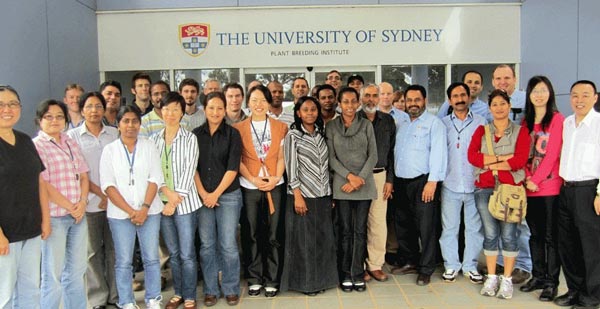
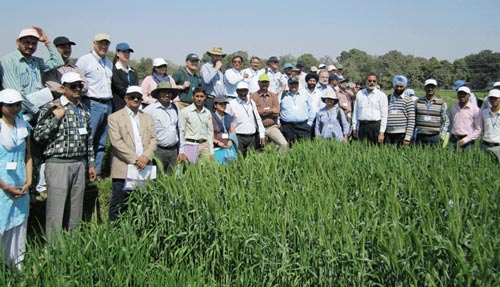 Meeting was held in the Indian holy city of Varanasi during 27 February to 01 March 2012. It was organized jointly by Banaras Hindu University (BHU), HarvestPlus, and CIMMYT to discuss wheat biofortification research outputs and future plans. The meeting was attended by about 40 scientists, including Hans Braun, Ravi Singh, Kevin Pixley, Velu Govindan, Etienne Duveiller, Arun Joshi, and Iván Ortiz-Monasterio from CIMMYT, along with participants from the Bill & Melinda Gates Foundation, HarvestPlus, the Indian national agricultural research system, the private sector, and more than 200 farmers from the eastern part of the state of Uttar Pradesh.
Meeting was held in the Indian holy city of Varanasi during 27 February to 01 March 2012. It was organized jointly by Banaras Hindu University (BHU), HarvestPlus, and CIMMYT to discuss wheat biofortification research outputs and future plans. The meeting was attended by about 40 scientists, including Hans Braun, Ravi Singh, Kevin Pixley, Velu Govindan, Etienne Duveiller, Arun Joshi, and Iván Ortiz-Monasterio from CIMMYT, along with participants from the Bill & Melinda Gates Foundation, HarvestPlus, the Indian national agricultural research system, the private sector, and more than 200 farmers from the eastern part of the state of Uttar Pradesh.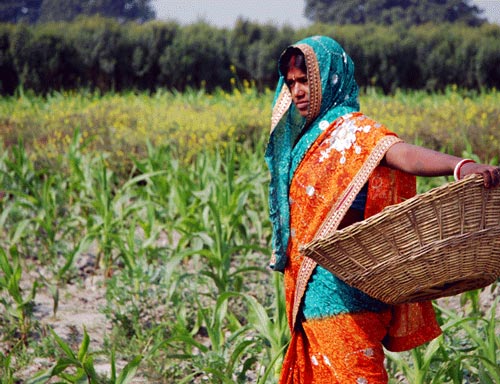 During 21 January-05 February, a delegation consisting of Director General Thomas Lumpkin, Global Wheat Program Associate Director and Head of Pathology, Etienne Duveiller, Board member Andy Barr, and Development Officer Cheraé Robinson travelled from El Batán to visit the three sites of the newly established Borlaug Institute for South Asia (BISA). They were accompanied by Ajai Kumar and Raj Gupta, from CIMMYT’s New Delhi office.
During 21 January-05 February, a delegation consisting of Director General Thomas Lumpkin, Global Wheat Program Associate Director and Head of Pathology, Etienne Duveiller, Board member Andy Barr, and Development Officer Cheraé Robinson travelled from El Batán to visit the three sites of the newly established Borlaug Institute for South Asia (BISA). They were accompanied by Ajai Kumar and Raj Gupta, from CIMMYT’s New Delhi office.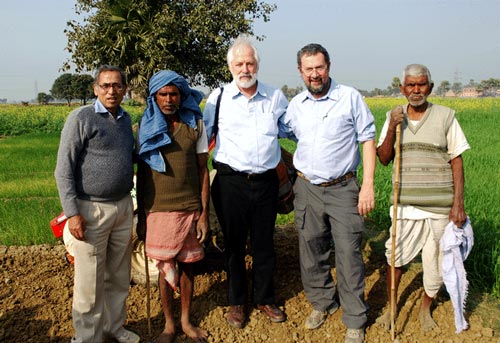
 A
A 
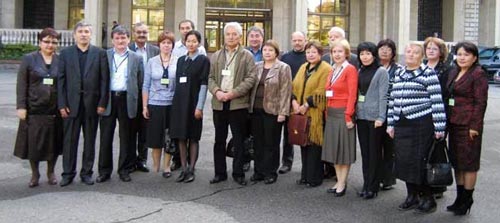
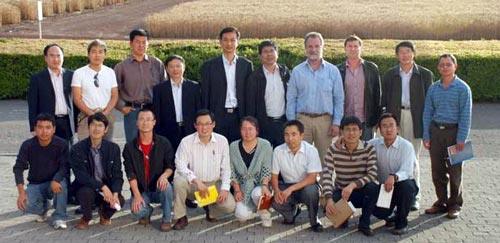
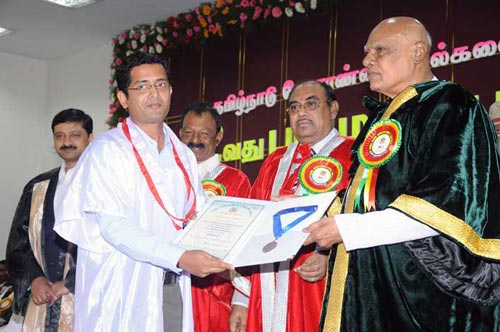 M.T. Vinayan has been working with P.H. Zaidi at CIMMYT-Asia, Hyderabad, and was recently awarded the 2011 gold medal for the ‘Best PhD student in Plant Breeding and Genetics’ from Tamil Nadu Agricultural University (TNAU), India. During the ceremony on 23 November 2011, Vinayan was also presented with the ‘Dr. R. Appadurai, Dr. R Rathinasamy, and Dr. S. Kannaiyan Award’ by the Governor of Tamil Nadu, K. Rosaiah. Vinayan conducted his thesis on “Genetic architecture of spotted stem borer resistance in sorghum as inferred from QTL mapping and synteny with the maize genome” under the guidance of C.T. Hash (Principal Scientist, ICRISAT) and K. Mohanasundaram (TNAU).
M.T. Vinayan has been working with P.H. Zaidi at CIMMYT-Asia, Hyderabad, and was recently awarded the 2011 gold medal for the ‘Best PhD student in Plant Breeding and Genetics’ from Tamil Nadu Agricultural University (TNAU), India. During the ceremony on 23 November 2011, Vinayan was also presented with the ‘Dr. R. Appadurai, Dr. R Rathinasamy, and Dr. S. Kannaiyan Award’ by the Governor of Tamil Nadu, K. Rosaiah. Vinayan conducted his thesis on “Genetic architecture of spotted stem borer resistance in sorghum as inferred from QTL mapping and synteny with the maize genome” under the guidance of C.T. Hash (Principal Scientist, ICRISAT) and K. Mohanasundaram (TNAU).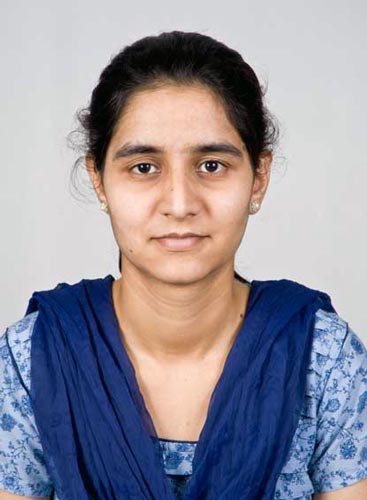 At the
At the